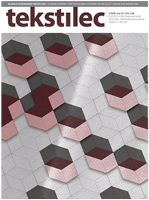
Tekstilec
Scope & Guideline
Empowering scholars through open access to textile advancements.
Introduction
Aims and Scopes
- Textile Materials Development:
Investigating new textile materials, including natural and synthetic fibers, and their applications in various industries such as automotive, fashion, and medical. - Sustainable Practices and Innovations:
Exploring eco-friendly methodologies in textile production, dyeing processes, and waste management to promote sustainability within the textile industry. - Functional and Performance Properties of Textiles:
Analyzing the physical, mechanical, and comfort properties of textiles, including their suitability for specific applications like sportswear, medical garments, and everyday clothing. - Technological Advancements in Textile Processes:
Researching advancements in manufacturing processes, including automated systems, computer modeling, and 3D printing technologies to enhance efficiency and quality in textile production. - Consumer Behavior and Market Trends:
Studying consumer perceptions, behaviors, and market dynamics related to textile and apparel products, focusing on sustainability and fast fashion implications.
Trending and Emerging
- Artificial Intelligence in Textiles:
The application of artificial intelligence in optimizing textile production processes and enhancing design capabilities is rapidly growing, reflecting technological advancements in the industry. - Sustainable and Eco-Friendly Innovations:
A marked increase in research addressing sustainability, including waterless dyeing methods and the use of biodegradable materials, aligns with global environmental concerns. - Health and Safety in Textiles:
The development of textiles for medical applications, including antimicrobial and antiviral properties, is gaining attention, particularly in response to increased health awareness. - Consumer Awareness and Fast Fashion Dynamics:
Research exploring consumer attitudes towards sustainability in fast fashion is trending, highlighting the importance of consumer behavior in driving industry changes. - Smart Textiles and Wearable Technology:
There is a growing interest in smart textiles that incorporate technology for enhanced functionality, catering to diverse applications from healthcare to sports.
Declining or Waning
- Traditional Textile Production Techniques:
Research focused on conventional textile production methods has seen a decline, likely due to the increasing emphasis on innovative and sustainable practices. - Basic Textile Properties Analysis:
While foundational studies on basic textile properties remain important, there is a noticeable shift toward more complex analyses involving multifunctional and smart textiles. - Non-Eco-Friendly Dyeing Methods:
Research on traditional dyeing processes that do not consider environmental impacts is becoming less frequent, as there is a growing preference for sustainable and innovative dyeing solutions. - General Textile Historical Studies:
Papers focusing on historical aspects of textiles and their cultural significance have decreased, overshadowed by more applied and technical research themes.
Similar Journals
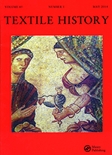
TEXTILE HISTORY
Stitching Together the Past and PresentTEXTILE HISTORY is a distinguished journal focusing on the rich tapestry of textile development across various historical contexts, published by Routledge Journals, Taylor & Francis Ltd. With origins dating back to 1968, this journal serves as a crucial platform for scholarly discourse in the fields of history, industrial and manufacturing engineering, and business management. It holds impressive rankings, including Q2 in History and ranks within the top 20% in Arts and Humanities, reflecting its significant contribution to understanding the socio-economic and cultural implications of textiles. Additionally, it operates under a traditional access model, ensuring that quality research is preserved within a structured environment. The journal is an invaluable resource for researchers, professionals, and students alike, aiming to advance knowledge and inspire future studies in textile history. Situated in the United Kingdom, the editorial team is committed to fostering a vibrant academic community that engages with the dynamic intersections of textiles, industry, and cultural heritage.
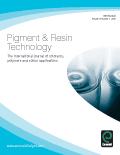
Pigment & Resin Technology
Unveiling Breakthroughs in Pigment and Resin ApplicationsPigment & Resin Technology is an esteemed journal published by Emerald Group Publishing Ltd, focusing on the interdisciplinary fields of materials chemistry and coatings science. With a history spanning from 1972 to 2024, the journal serves as a vital platform for disseminating innovative research and developments concerning pigments, resins, and related materials technologies. Holding a respectable position in the Q3 category for both Materials Chemistry and Surfaces, Coatings, and Films as of 2023, it ranks within the 40th percentile among its peers, underscoring its relevance and impact within these domains. Although it does not currently offer open access, the journal remains a key resource for researchers, professionals, and students aiming to stay abreast of cutting-edge findings and practical applications in materials science. As such, Pigment & Resin Technology is essential reading for those engaged in the innovation and application of advanced materials in various industries.

Fibers is a leading peer-reviewed open access journal published by MDPI, focusing on cutting-edge research within the realm of materials science, particularly in the domains of biomaterials, ceramics and composites, and structural engineering. Established in 2013, the journal has gained recognition for its significant contributions to the field, boasting an impact factor that positions it in the Q2 quartile across multiple categories such as Biomaterials, Ceramics and Composites, Civil and Structural Engineering, and Mechanics of Materials as of 2023. With a Scopus ranking that highlights its prominence—such as in the top 20% in Civil and Structural Engineering—the journal fosters an inclusive platform for academic dialogue and technical advancement. Researchers and professionals can access the journal’s comprehensive articles freely, promoting the dissemination of knowledge that is crucial for the advancement of innovative materials and their applications. Situated in Basel, Switzerland, Fibers continues to be an essential resource for those looking to stay at the forefront of research and technology in material sciences.

Tekstil ve Konfeksiyon
Connecting Researchers and Practitioners in Textile InnovationTekstil ve Konfeksiyon, a distinguished journal published by the E.U. Printing and Publishing House, serves as a vital resource in the fields of Industrial and Manufacturing Engineering as well as Materials Science. With an ISSN of 1300-3356, this Turkish journal has witnessed significant development since its inception in 2008, continuing to contribute valuable insights and advancements through 2024. Although categorized in the third quartile (Q3) for Industrial and Manufacturing Engineering and the fourth quartile (Q4) for Materials Science, the journal ranks respectably within its fields—249th out of 384 and 357th out of 463, respectively, according to Scopus. Researchers, professionals, and students can gain access to a variety of cutting-edge studies and applications that reflect the latest trends and innovations in textile and apparel technology. The journal emphasizes the importance of practical applications and interdisciplinary research, fostering a platform for knowledge exchange and development aimed at pushing the boundaries of textile and clothing sciences.
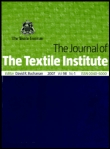
JOURNAL OF THE TEXTILE INSTITUTE
Fostering collaboration in the vibrant world of textiles.The Journal of the Textile Institute, published by Taylor & Francis Ltd, is a renowned academic journal that has been pivotal in advancing research and innovation in the textile industry since its inception in 1967. With a robust ISSN of 0040-5000 and an E-ISSN of 1754-2340, this journal serves as a vital resource for researchers, practitioners, and students interested in the multifaceted aspects of textiles, encompassing agricultural and biological sciences, industrial engineering, and materials science. With a respectable impact factor reflected in its Q2 quartile rankings in the 2023 categories of Agricultural and Biological Sciences, Industrial and Manufacturing Engineering, and Polymers and Plastics, the journal stands out in the academic landscape—offering high-quality, peer-reviewed articles that foster knowledge exchange and innovation. Researchers and professionals alike will find this journal's commitment to exploring contemporary challenges and technological advancements ultimately invaluable for both academic inquiries and practical applications in the textile field.

Journal of Cotton Science
Leading the Way in Cotton Science ExplorationJournal of Cotton Science is a vital publication dedicated to advancing the understanding and innovative practices within the cotton industry. Published by the NATIONAL COTTON COUNCIL OF AMERICA, this journal has been a key resource for researchers, agronomists, and industry professionals since its inception in 1997, with contributions spanning various aspects of cotton science, including breeding, genetics, pest management, and environmental impact. With an ISSN of 1523-6919 and an E-ISSN of 1524-3303, it currently holds a Q3 ranking in the Materials Science (miscellaneous) category as per the 2023 quartiles. While the journal operates without open access, it remains accessible to professionals looking to contribute to its expanding reach. The Journal of Cotton Science plays a pivotal role in disseminating cutting-edge research and fostering collaboration among scientists, positioning itself as an essential resource in the ongoing exploration of cotton's material science applications. Stay up to date with the latest findings and developments that shape the future of this crucial agricultural product.
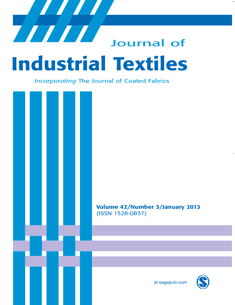
Journal of Industrial Textiles
Transforming Materials Science through TextilesJournal of Industrial Textiles, published by SAGE Publications Inc, is a leading academic journal that focuses on the intricate interplay between textile materials and industrial applications. With a significant impact factor and a strong reputation in the field, it caters to a diverse audience ranging from researchers and professionals to students interested in the advancement of textile engineering, chemical engineering, and materials science. The journal offers invaluable insights into innovative textile processes, sustainable practices, and the latest technological developments as it spans research contributions from 1971 to the present. Notably, it ranks in the second quartile across various categories, including Chemical Engineering and Industrial and Manufacturing Engineering, reflecting its influence and quality in the scientific community. Although it is not an open access journal, the Journal of Industrial Textiles remains a critical resource for advancing knowledge and fostering collaboration within the textile sector and related fields.

PLASTICS RUBBER AND COMPOSITES
Unveiling the Potential of Composite MaterialsPLASTICS RUBBER AND COMPOSITES is a leading academic journal published by SAGE Publications Inc., dedicated to advancing the understanding and application of polymers, plastics, and composite materials. With an ISSN of 1465-8011 and an E-ISSN of 1743-2898, this quarterly publication attracts a diverse readership from the fields of ceramics and composites, chemical engineering, materials chemistry, and polymer science. Currently indexed in the Q3 category across multiple relevant domains, the journal provides a platform for high-quality research and innovations that contribute significantly to material science. The journal's commitment to disseminating cutting-edge research makes it a valuable resource for researchers, industry professionals, and students who are eager to explore the latest developments and applications in this dynamic field. Despite its current non-open access status, the journal's rigorous peer-review process ensures that all published articles meet the highest academic standards, thus reinforcing its reputation as an essential source for scholarly work in the materials sector.

Journal of Natural Fibers
Innovating the World of Natural Fiber ApplicationsJournal of Natural Fibers is a pioneering open-access academic journal, published by Taylor & Francis Inc, that focuses on the emerging and multidisciplinary field of natural fibers. Established in 2004, the journal aims to advance the understanding and application of natural fibers in various industries, including materials science, textiles, and biocomposites. With an impressive impact factor and ranking in the 74th percentile among materials science journals, it is classified as Q2 in materials science (miscellaneous) as of 2023. The journal encourages innovative research and provides a platform for scientists, researchers, and professionals to share their findings in a rapidly evolving field. Notably, since 2023, it has embraced an open-access model, enhancing the accessibility of cutting-edge research to a broader audience. With contributions from a diverse range of countries and a commitment to high-quality peer review, the Journal of Natural Fibers is essential for those looking to explore the sustainable potentials and technological advancements of natural fibers.

Research Journal of Textile and Apparel
Fostering collaboration in textile and apparel scholarship.Research Journal of Textile and Apparel, published by Emerald Group Publishing Ltd, serves as a pivotal platform for advancing knowledge in the fields of textile and apparel research. With an ISSN of 1560-6074, this journal has been disseminating quality research since its inception in 1997, and it continues to contribute valuable insights through to 2024. The journal holds a Q3 ranking across multiple categories, including Business and International Management, Industrial and Manufacturing Engineering, Management of Technology and Innovation, and Materials Science, reflecting its commitment to high standards of scholarship. Although not an open-access journal, it provides a vital resource for researchers, professionals, and students eager to explore innovative textile technologies and sustainable practices within the fashion industry. As the textile sector navigates significant challenges and opportunities, this journal is uniquely positioned to foster collaboration and enhance understanding among diverse stakeholders.